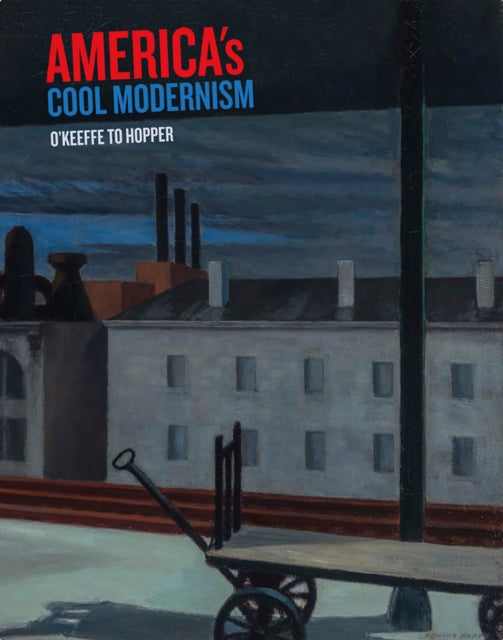Katherine Bourgignon
America's Cool Modernism: O'Keeffe to Hopper
America's Cool Modernism: O'Keeffe to Hopper
YOU SAVE £5.66
- Condition: Brand new
- UK Delivery times: Usually arrives within 2 - 3 working days
- UK Shipping: Fee starts at £2.39. Subject to product weight & dimension
Bulk ordering. Want 15 or more copies? Get a personalised quote and bigger discounts. Learn more about bulk orders.
Couldn't load pickup availability
- More about America's Cool Modernism: O'Keeffe to Hopper
American artists used clean, orderly brushwork or close-up, unemotional photography to convey abstraction, which involved absence and presence. They drew inspiration from cubism, machine parts, and new technologies, aiming to bring order to the modern world through extreme simplification. Their artworks provide a new context for the precisionist works in the subsequent sections and highlight modern ideas about what art could be.
Format: Paperback / softback
Length: 184 pages
Publication date: 21 March 2018
Publisher: Ashmolean Museum
As some American artists sought to simplify their compositions and eliminate human figures, they often employed precise and orderly brushwork or close-up, unemotional photography. Artists ranging from Patrick Henry Bruce to Georgia O'Keeffe, John Covert to Paul Strand, and Arthur Dove traversed European and American avant-garde circles, actively absorbing and selecting new ideas and techniques. Their inspiration drew from diverse sources, including cubism, machine parts, and emerging technologies, all aimed at finding ways to bring order to the chaotic modern world. For these artists, abstraction entailed a complex interplay between absence and presence. It involved the deliberate removal of human presence while also striving to depict unseen or overlooked aspects of reality, such as the passage of time, sound waves, or weather patterns. Their artworks serve as a valuable context for the precisionist works that follow, offering a glimpse into the evolving ideas about what art could be in the early 20th century.
In their pursuit of abstraction, these artists explored various methods to achieve their desired effect. Some employed precise and geometric brushstrokes, creating clean and structured compositions that emphasized form and shape. Others used close-up photography to capture intricate details and textures, emphasizing the visual richness of everyday objects. Some artists even combined these techniques, creating intricate collages that juxtaposed different elements and perspectives.
One of the key aspects of abstraction was its ability to convey emotions and ideas without relying on traditional representational techniques. By removing human figures and focusing on abstract forms and patterns, artists were able to create works that were open to interpretation and could evoke a range of emotions and responses. This freedom of interpretation allowed for a broader range of artistic expression and paved the way for the development of modern art movements such as surrealism and abstract expressionism.
Furthermore, abstraction played a significant role in shaping modern ideas about what art could be. It challenged traditional notions of what art should represent and opened up new possibilities for artistic expression. It demonstrated that art could be more than just a visual representation of reality and could be used to explore and communicate complex ideas and emotions.
In conclusion, the emergence of abstraction in American art during the early 20th century was a transformative moment in the history of art. Artists sought to simplify their compositions and eliminate human figures, employing precise and orderly brushwork or close-up, unemotional photography. Their inspiration drew from diverse sources, including cubism, machine parts, and emerging technologies, all aimed at finding ways to bring order to the chaotic modern world. Through abstraction, artists were able to convey emotions and ideas without relying on traditional representational techniques, opening up new possibilities for artistic expression and shaping modern ideas about what art could be.
Weight: 908g
Dimension: 221 x 279 x 16 (mm)
ISBN-13: 9781910807217
This item can be found in:
UK and International shipping information
UK and International shipping information
UK Delivery and returns information:
- Delivery within 2 - 3 days when ordering in the UK.
- Shipping fee for UK customers from £2.39. Fully tracked shipping service available.
- Returns policy: Return within 30 days of receipt for full refund.
International deliveries:
Shulph Ink now ships to Australia, Belgium, Canada, France, Germany, Ireland, Italy, India, Luxembourg Saudi Arabia, Singapore, Spain, Netherlands, New Zealand, United Arab Emirates, United States of America.
- Delivery times: within 5 - 10 days for international orders.
- Shipping fee: charges vary for overseas orders. Only tracked services are available for most international orders. Some countries have untracked shipping options.
- Customs charges: If ordering to addresses outside the United Kingdom, you may or may not incur additional customs and duties fees during local delivery.


